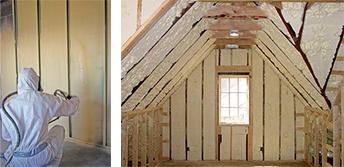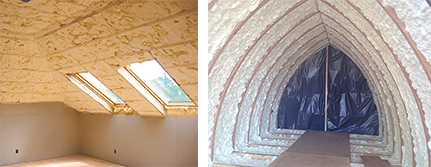Spray applied insulation: high performance heat loss mitigation

Paddy Leighton, UK director for spray foam insulation specialists Icynene, looks at heat loss in buildings and how new, high performance insulation systems can improve comfort levels in old and so called ‘difficult to treat’ buildings.
When Britain began its post war building boom, coal was king and energy was relatively cheap. Little thought was given to heat loss and few buildings were constructed with any meaningful level of insulation.
Seventy years on and the world is very different. With sky-high heating costs and a greater focus on the need to reduce energy consumption, builders, landlords, homeowners and custodians of historic buildings all take the insulation of their respective properties much more seriously.
How insulation works
To understand how insulation works it helps to understand heat flow, which involves three basic mechanisms – conduction, convection and radiation.
Conduction is the way heat moves through materials, such as when a spoon placed in a hot cup of coffee conducts heat through its handle to your hand.
Convection is the way heat circulates through liquids and gases. It is why lighter, warmer air rises, and cooler, denser air sinks.
Radiant heat travels in a straight line and heats anything solid in its path – think about sitting in front of a roaring open fire and how you feel warm on the side facing the fire but less so on the other!
Insulation materials work by slowing conductive heat flow and, to a lesser extent, convective heat flow. Regardless of the mechanism, heat flows from warmer to cooler areas until there is no longer a temperature difference. In a typical home, this means that in winter heat flows directly from all heated living spaces to adjacent unheated roof voids, garages and cellars – and particularly to the outdoors.
How can we insulate effectively?
Retrospective insulation – that which is fitted after construction of the building – has traditionally taken the form of thick layers of glass or mineral fibre placed between rafters in the roof void, or blown in cavity wall insulation such as styrene beads or mineral wool.
 These forms of insulation work well but they do not significantly address the crucial factor of preventing convective heat loss.
These forms of insulation work well but they do not significantly address the crucial factor of preventing convective heat loss.
In the UK, U-values are the measure of insulation’s ability to limit conductive heat flow – the lower the U-value the better the resistance to heat loss. However, it should be noted that up to 40% of a building’s heat loss can be attributed to air leakage.
Therefore, the best way to increase the energy efficiency of a building is to combine U-value reduction with an air barrier – creating a ‘sealed box’ effect to reduce air (and heat) leakage to a minimum. As levels of air tightness increase, consideration should be given to the introduction of efficient mechanical ventilation.
Spray applied insulation
Traditional forms of insulation are relatively inefficient in sealing the box, in that they cannot completely fill all voids or seal the interface between the insulation and the building structure. This can lead to cold bridging and localised condensation and dampness.
The modern alternative is foam insulation, which is applied using a pressurised gun system. Insulation is applied as a mixture of two components that come together at the tip of a gun, forming a foam that expands 100-fold within seconds, sealing all gaps, service holes and hard to reach spaces, virtually eliminating cold bridging and air leakage.
Unlike the urethane foams of 20 years ago, modern spray foams such as Icynene Foam Lite use water as the blowing agent. This means that the reaction between the two components produces CO2 which causes the foam to expand. Cells of the foam burst and the CO2 is replaced by air.
This ‘open cell’ foam provides outstanding insulation properties but still allows the building to breathe naturally.
Where does spray applied insulation fit?
Spray applied insulation tends to be more expensive but its speed of installation, its ability to perform in difficult to treat applications and the fact that it can be injected into voids that would otherwise require invasive tear-out of surfaces, means spray foam is a very cost-effective solution.
Icynene has been used on many historic buildings where its non-invasive installation methods have allowed the continued occupation of the building and negligible impact to the fabric or the breathability of the structure.
The fact that spray foam insulation can create an air-tight envelope has also made it the insulation material of choice in modern, new build homes built to Passivhaus-type standards.
For further information on Icynene spray applied insulation visit the website at www.icynene.co.uk. A video is also available to view at https://youtu.be/xn4ZHQJLWHM















